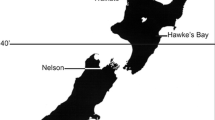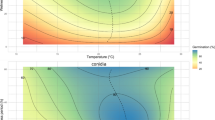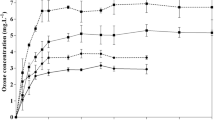Abstract
The syndrome of bud necrosis, a storage disease of tulips, is analysed and relationships between several phenomena are described:
-
1.
In ‘White Sail’, bud necrosis occurred in cardboard boxes only when bulbs infected withFusarium oxysporum f. tulipae were present.
-
2.
Buds with symptoms of bud necrosis were open at the tip.
-
3.
Whereas in ‘White Sail’, open buds occurred in boxes only whenFusarium-infected bulbs were present, in ‘Red Champion’, open buds occurred also in well-ventilated open trays with wire-gauze bottoms stored at higher temperatures but withoutFusarium-infected bulbs. In ‘Rose Copland’, open buds were only found exceptionally.
-
4.
In buds with symptoms of bud necrosis, mites were almost always present.
-
5.
In boxes in whichFusarium-infected bulbs were present, ethylene concentrations up to 23 ppm were found.
On the basis of these findings it seems highly probable that bud necrosis develops only if mites penetrate into the buds and reach the stamens. A prerequisite for penetration is the presence of a pore in the bud tip. Ethylene, emanated byFusarium-infected bulbs or from other sources and accumulating under conditions of poor ventilation, is probably the direct cause of open buds.
In ‘Red Champion’, however, this aberration can also be caused by higher storage temperatures even with good ventilation. In a subsequent paper proof of this hypothesis will be presented.
Samenvatting
In een voorgaande publikatie werd gesuggereerd dat kernrot ontstaat door een combinatie van faktoren. De aard ervan was tot nu toe onbekend.
Om deze faktoren te identificeren zijn het ziektesyndroom en de bewaaromstandigheden verder geanalyseerd. Enkele relaties konden worden vastgesteld, die het opstellen van een verklaringshypothese mogelijk maken.
Deze relaties zijn: 1. Bij ‘White Sail’ komt kernrot voor als de bollen worden bewaard in doosjes waarin ook bollen voorkomen die aangetast zijn doorFusarium oxysporum f. tulipae (‘zure bollen’); 2. Knoppen met symptomen van kernrot zijn aan de toppen open. Dit komt zowel bij ‘White Sail’ en ’Red Champion’ voor als bij ’Rose Copland’. Als deze afwijking in sterke mate optreedt groeien de meeldraden door de opening aan de top van de knop; 3. Open knoppen komen bij ‘White Sail’ alleen voor in doosjes waarin ook ‘zure bollen’ voorkomen. Bij ‘Red Champion’ kan dit verschijnsel behalve door bewaring in doosjes samen met ‘zure bollen’, ook ontstaan tengevolge van hogere bewaartemperaturen (20–23°C). Bij ‘Rose Copland’ komen open knoppen slechts bij uitzondering voor; 4. In knoppen met symptomen van kernrot komen bijna steeds mijten voor; 5. In doosjes waarin ‘zure bollen’ voorkomen, is ethyleen aangetoond in concentraties variërend van 0 tot 23 dpm.
Op grond van bovenstaande relaties is de hypothese opgesteld dat kernrot alleen dan ontstaat, wanneer mijten tot in de bloemknoppen kunnen doordringen en de meeldraden kunnen bereiken. Voorwaarde hiervoor is de aanwezigheid van een opening in de top van de knop.
Ethyleen uit metFusarium besmette bollen is waarschijnlijk het werkzame agens bij het ontstaan van open knoppen in ‘White Sail’ en ‘Red Champion’, onder omstandigheden van slechte ventilatie. Bij ‘Red Champion’ kan het verschijnsel ook bij goede ventilatie en dan tengevolge van hoge bewaartemperaturen ontstaan.
Resultaten van verder onderzoek die de hypothese bevestigen, zullen in een volgende publikatie worden beschreven.
Similar content being viewed by others
References
Burg, S. P., 1962. The physiology of ethelene formation. A. Rev. Pl. Physiol. 13:265–302.
Elmer, O. H., 1936. Growth inhibition in the potato caused by a gas emanating from apples. J. agric. Res. 52:609–626.
Hitchcock, A. E., Crocker, W. & Zimmerman, P. W., 1932. Effect of illuminating gas on the lily, narcissus, tulip and hyacinth. Contr. Boyce Thompson Inst. Pl. Res. 4:155–176.
Hodson, W. E. H., 1928. The bionomics of the bulb mite, Rhizoglyphus echinopus, Fumouze & Robin. Bull. ent. Res. 19:187–200.
Kamerbeek, G. A. & Munk, W. J. de, 1966. Kernrot in tulpen. Jversl. Lab. BloembollOnderz. Lisse, 1965:20–21.
Kamerbeek, G. A. & Munk, W. J. de, 1968. Kernrot in tulpen. Jversl. Lab. BloembollOnderz. Lisse, 1967/1968:26–27.
Knight, L. I. & Crocker, W., 1913. Toxicity of smoke. Bot. Gaz. 55:337–371.
Lloyd, B. B., 1958. A development of Haldane's gas-analysis apparatus. J. Physiol. 143:5–6.
Meigh, D. F., 1959. Nature of the olefins produced by apples. Nature, Lond. 184:1072–1073.
Munk, W. J. de & Beijer, J. J., 1971. Bud necrosis, a storage disease in tulips. I Symptoms and the influence of storage conditions. Neth. J. Pl. Path. 77:97–105.
Munk, W. J. de, & Rooy, M. de, 1971. The influence of ethylene on the development of 5°C precooled ‘Apeldoorn’ tulips during forcing. Hort. Sci. 6:40–41.
Neljubov, D., 1911. Geotropismus in der Laboratoriumsluft. Ber. dt. bot. Ges. 29:97–112.
Seemüller, E., 1968. Mitt. biol. BundAnst. Ld- u. Forstw. 127; p. 26.
Wijvekate, M. L., 1960. Verklarende statistiek, Utrecht.
Author information
Authors and Affiliations
Rights and permissions
About this article
Cite this article
De Munk, W.J. Bud necrosis, a storage disease of tulips. II. Analysis of disease-promoting storage conditions. Netherlands Journal of Plant Pathology 77, 177–186 (1971). https://doi.org/10.1007/BF01977276
Accepted:
Issue Date:
DOI: https://doi.org/10.1007/BF01977276




